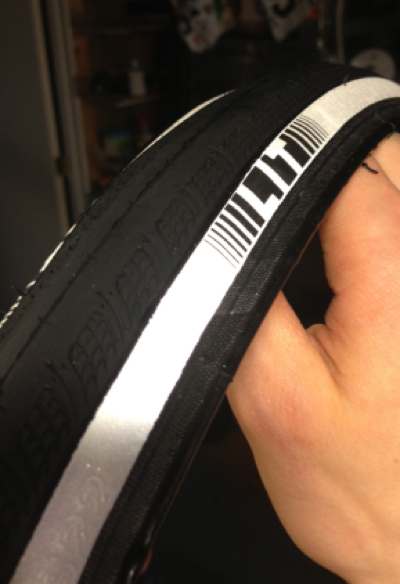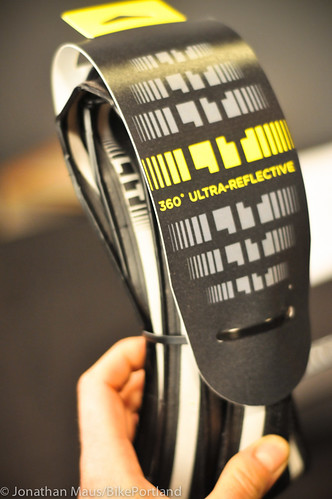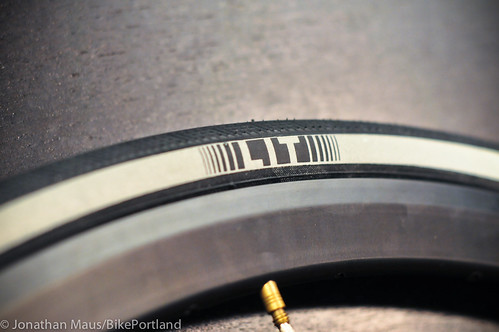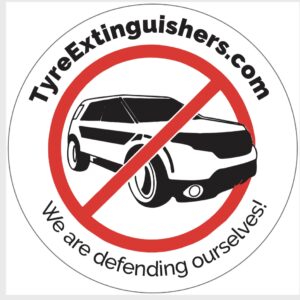This review was written by Scott Kocher, a Portland-based trial lawyer whom I met while biking in Forest Park last year. He’s also an alternate member of the City of Portland Pedestrian Advisory Committee and a dedicated transportation activist.
——
LIT 360 Ultra-Reflective Road Tire (Retail: $49.99)
It’s impressive that Portland-based Velo Products took the crowd-funding route to make their LIT Tires concept a reality. The tires themselves are equally impressive.
I pre-ordered a pair last April because the company is local, they partnered to support the BTA with their sales, and the tire design has Portlanders’ needs in mind. As the months ticked by, I got e-mail updates, mostly describing manufacturing snags. At one point they offered to refund our money because of the delays. I stuck it out, and my tires arrived last week. I’m glad I did.
The advertised stats are:
- 700×28 Aramid-bead, Folding
- Puncture Protection Layer
- Long-Life Tread Compound
- Ultra-Reflective 9mm Sidewall
- Weight 250g
They are true to spec. They weigh within my scale’s margin of error of the claimed weight. If you care, they’re only about 25 grams heavier than a 25mm Continental Grand Prix 4000s clincher, a stellar tire found on many race bikes including mine. As for width, the LITs measure almost exactly the same as the generously-sized 25mm Continentals, and the same as a 28mm Schwalbe Marathon Supreme or a 28mm Panaracer RiBMo PT. They fit fine in a standard road bike rim brake caliper and should fit any frame except some extremely narrow TT or aero frames.
The LITs mounted easily without tools on my Weinmann XC-260 rims (ETRTO 622×20). The beads seated in the rim evenly when inflated, and they spin without any lumps. The reflective stripe on the LITs is wide and even, putting the one on my pricey Schwalbe Marathon Supreme to shame. The stripe is especially nice with disc brakes, which don’t get the sidewalls dirty like rim brake pads do when wet.
So far, I’ve put the LIT Tires to the test on two hilly rain rides, on roads littered with storm debris. They performed extremely well. Most importantly, they have excellent grip on wet asphalt. To the touch, the compound feels grippy, not the waxy texture I’ve learned to avoid. The casing is supple but not thin, and the ride feels similar to other tires of similar width and weight. Compared to a 23mm tire, the extra volume certainly adds comfort and reliability. Given that the speed penalty—or possibly gain—of a wider tire is a topic of current debate, the 28mm LITs should be a popular choice. The tires appear well-made, so I’m optimistic about durability and flat-protection.

Targeted at the urban commuter market, the LIT Tires would also be an excellent choice for year-round touring or training. The highly reflective sidewalls are a nice feature any time or place. As with any retro-reflective material, they only help with visibility by reflecting light back to its source. That means they’re great to help a person driving a car see you when you are in the car’s headlights.
Bottom line, congratulations and thank you to the folks at Velo Products for getting a great product to market. I look forward to getting another pair of them down the road.
Publisher’s Note: I’ve also used these tires and I’ve learned more about them from company.
Velo Products is a new company owned by Portland-based Velotech. Velotech also owns the Western Bike Works retail store at NW 17th and Lovejoy and several e-commerce sites including WesternBikeWorks.com, BikeTiresDirect.com, and Cyclocross.com. The LIT tires were designed and developed by Velo Products employees and made in Europe. The tires are just the first product in what’s expected to be a full line of “reflective accessories and urban riding gear” to come, says a company spokesman.
I received a pair of the tires last week. I echo Scott’s enthusiasm for both the tires and the company; but I do want to share an important caveat.
I used the tires for a big ride last Sunday down to Salem where I took part in the 50-mile “Gravel Grinder” ride (a.k.a. the “Perry Roubaix”). On the 70-mile ride to the start of the loop ride, the tires were great. Since the first two hours of my ride were before sunrise, I loved having the big reflective sidewalls and the tires themselves felt fast and stable.
Once on the gravel ride, however, things changed dramatically. I flatted right as the gravel started (most of the route was gravel). I chalked it up to just bad luck, repaired the tire, and went on my way. Then I got another flat a few miles later. Then another one. Then another. By the end of the day, I had pulled over 6 times to repair a total of 11 punctures: five in the front and six in the rear. All of them were classic snake-bites caused by sharp rocks.
I didn’t flat once on the pavement during the all-day ride which totaled 182 miles once we rode home from Salem after the Gravel Grinder.
In hindsight, it seems I chose the wrong tires for the conditions. Velo Products says the tires are for “training and winter commuting.” Not only does Velo Products not recommend them for gravel riding, but the type of gravel we encountered down in Salem was particularly sharp and nasty on tires. I heard there were a lot of flats on Sunday.
I told Patrick Croasdaile at Velo Products about my experience. After asking a bunch of questions about my set-up, he conferred with his design team and sent over this statement:
“We do not recommend using the current iteration of the LIT for gravel riding. This tire was designed as a performance-oriented, road, training tire. We suspect that, based on the sheer number of pinch flats, the tires were not adequately inflated. Once we have a 700×32 in production, we’ll encourage you to give this a go again.”
You can learn more about LIT tires on their crowd-funding page and purchase them online at WesternBikeWorks.com. There’s also this fun video created by the Western Bike Works crew.
(And yes, as you can see below and in our sidebar, Velotech/Western Bike Works, is a BikePortland advertiser.)








not the first or the last tire with reflective sidewalls for bikes, I fail to see what makes this tire stand out from any of the others, except maybe the excessive price.
For starters, all the features listed:
I don’t know how good that puncture protection is – lots of tires claim it, many don’t live up to it. Schwalbe Marathon Supremes will cost you $65-85 per tire and they’re worth every cent. I rode a pair for more than 5,000 miles down to the fibers below the rubber and never once had a flat on them.
The reflective bit on these tires is significantly more surface area than a typical reflective sidewall. Like many times more. That said, even a modest 3mm reflective sidewall, like the ones I have on my tires are immensely visible. I don’t know why that would have to made larger, but it can’t hurt.
Ah. Now I get the wider band. Because it’s not tucked in so close to the rim, it offers a wider field of reflectivity (“near 360°” as described in the video http://www.crowdsupply.com/bike-soles/lit-reflective-bike-tire). Traditional reflective sidewalls are typically only visible in near perpendicular circumstances – the demo video shows clearly how well these work as a car approaches from the rear or opposing direction as well.
Hopefully they get a 32mm option before my current tires wear out. I’d be willing to give these a go.
How do the schwalbes compare to other puncture resistant tires, i.e specialized armadillos or continentals?
I’ve had a puncture on a Continental. Haven’t tried an Armadillo. Never had a puncture on the Schwalbe Marathon Supremes. Schwalbe has different puncture resistant tires and they’re not all the same class (some are heavier, etc.) – but the Supremes specifically are really nice.
I’m interested to hear comparisons against the Schwalbe Durano Plus tire. This tire is quite a bit lighter, but I wonder how the flat protection compares. I haven’t taken the Duranos on any crazy gravel roads, but I’ve never had a flat on gravel, having done a few dozen miles here and there on gravel sections.
Sounds like Jonanthan got “snake-bite” flats from under inflation. Personally, I would have run higher pressure after the first pinch flat.
The many potential causes of punctures and how to avoid them would be a good article.
I might have had too low of pressure for the first flat or so, but I thought I pumped it up pretty hard after the 4th or 5th flat. I guess I didn’t though! I’m learning a lot lately about tires, pressure, and so on. Chalk this up to a learning experience for sure.
and maybe a techie piece on what’s the optimum rubber for a combo paved/gravel ride like this.
Why would you try to run 28s on gravel?
Hi Jane,
I’ve ridden 28s on gravel quite a bit. You’d be surprised what you can ride gravel on. It’s really about the specific gravel conditions, the tire itself (design, rubber compound, thickness, etc..), the rider’s experience and weight, tire pressure, and so on.
But it’s definitely not crazy to ride 28mm tires on gravel.
For what it’s worth, I did the same ride as Jonathan on Continental Grand Prix 4 Season 28c tires inflated to about 80 psi and had zero flats. I ran across him several times during the ride both mid and post flat and was shocked at how well he took this situation in stride. I personally would have been less, um… understanding.
Take the Nestucca River Road to the coast some time. You see people riding the 3 mile gravel section with 23s, 25s. Everything. I ran 25s and had no problems.
Sure. But why?
Because 3 miles of gravel will not necessarily dictate what you want to ride for the other 100 miles of pavement.
I read the website for the Gravel Grinder a few weeks ago, and I seem to recall they said you should not do the ride unless you have a hardcase tire. I don’t see anywhere how this tire meets that definition. What were you thinking, Jonathon?
I’ve admitted that I used the wrong tires on this ride.
What was I thinking? Well, it was a bike ride and I had some tires I wanted to try. So I did. I didn’t realize a standard set of road/commuting tires would have so much trouble in those conditions. (And FWIW, I did ride Leif Ericson through Forest Park with them last Friday and had no problems at all).
In my experience with another brand, reflective sidewalls are great until they become coated with road grim and no longer reflect light. Not the type of dirt that is easy to wash off, but the kind that grays/dulls any white soft surface and is impossible to clean without taking off the reflective material. If these or another reflective tire had a non-stick coat, that would make a world of difference.
I’ve never had reflective sidewalls that come off with a cleansing scrub (and I always buy tires with them). I recommend you don’t buy whatever brand that was again.
I had Schwalbes on for 3 years, never a problem with reflective coating dimming
these tires are called LIT and claim “360° ultra-reflective” so I was very interested in seeing the lit up reflective properties from all angles…
I’m very disappointed…
not a single shot of them at night, and especially the one I wanted; a shot of them at night from the rear to see how their claim of 360° held up…
Hey Spiffy, check out the LIT’s Product Video on Western Bikeworks’ YouTube Channel:
http://www.youtube.com/watch?v=vVTeiY2cCiA
The specific shots you’re looking for start @ 1:00
The video has ample footage of the tires at night, from the vantage of a car approaching from behind.
The video shows a shot from directly behind. They are surprisingly reflective from a sharp angle, but of course if you’re directly behind the reflective material isn’t visible. Maybe you could wobble a bit while you ride.
http://www.crowdsupply.com/bike-soles/lit-reflective-bike-tire
I’ve ridden 28c in heavy gravel they did great any anything below fist-sized rock. What kind of pressure were you running during the gravel riding? Seems like after 2 pinch flats I’d pump them up to the absolute max rating. Maybe the reflective sidewall is thinner or differently treated than other sidewalls making it more prone to pinch flats?
PS 182mi, in Feb? Wow!
Pinch flats don’t happen from low tire pressure on a non rigid, semi-fluid surface like gravel, they happen due to low tire pressure when the tire hits a rigid object, like a curb or exiting edge of a pothole. Sounds like the tires just aren’t very tuff and prone to puncture.
probably would have worked better with a gravel-specific frame.
I guarantee that his lack of disc brakes was a factor.
Exactly. And no aero bars? No wonder he flatted 11 times.
What is this, Pinkbike? 26 4 life!!
Definitely not the correct gravel-specific geometry for the conditions. Rookie mistake to take a soft-to-medium packed loam frame on an epic gravel ride.
You reckon he forgot his gravel-specific socks, too?
Forgive my ignorance. I don’t ride narrow (narrower than 32mm) tires, have a disk brake bike or have done much gravel riding. How would disk brakes help?
He is being facetious
Now if we could get these in 26×2, or (dare to dream) 26×2.35, that would be fun.
I wouldn’t expect any 250g tire to be tough enough for real gravel grinding, even with a puncture belt. Going up to 32 should help significantly, but it will be more ideal if they also beef the casing up a tad, so its durability is more in line with what’s expected of commuter tires in the 32-38mm range.
As a roadie, I love the idea of a light tire with a bigger contact patch for wet conditions. Reflective sidewalls is a nice bonus.